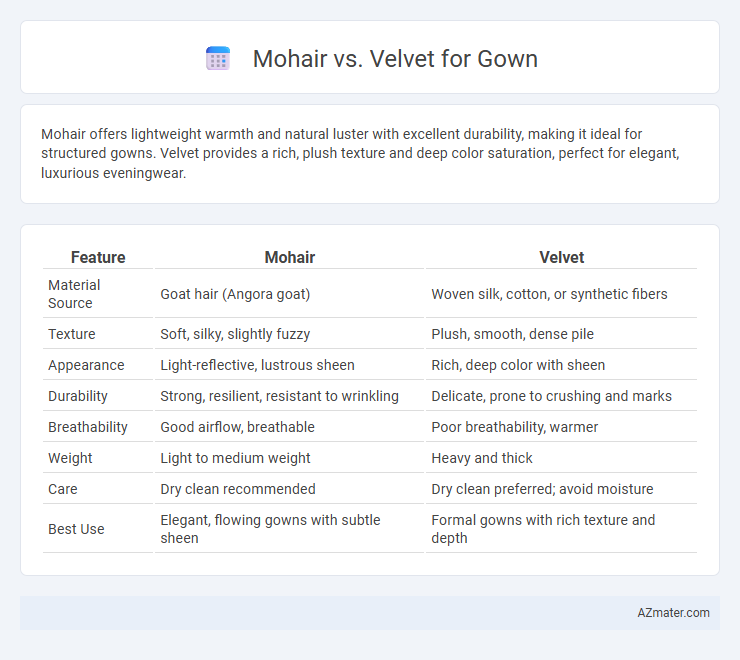Mohair offers lightweight warmth and natural luster with excellent durability, making it ideal for structured gowns. Velvet provides a rich, plush texture and deep color saturation, perfect for elegant, luxurious eveningwear.
Table of Comparison
| Feature | Mohair | Velvet |
|---|---|---|
| Material Source | Goat hair (Angora goat) | Woven silk, cotton, or synthetic fibers |
| Texture | Soft, silky, slightly fuzzy | Plush, smooth, dense pile |
| Appearance | Light-reflective, lustrous sheen | Rich, deep color with sheen |
| Durability | Strong, resilient, resistant to wrinkling | Delicate, prone to crushing and marks |
| Breathability | Good airflow, breathable | Poor breathability, warmer |
| Weight | Light to medium weight | Heavy and thick |
| Care | Dry clean recommended | Dry clean preferred; avoid moisture |
| Best Use | Elegant, flowing gowns with subtle sheen | Formal gowns with rich texture and depth |
Introduction to Mohair and Velvet
Mohair, derived from the Angora goat, is celebrated for its lustrous sheen, durability, and natural elasticity, making it an excellent choice for elegant gowns that require both structure and softness. Velvet, a luxurious fabric characterized by its dense pile and rich texture, offers a sumptuous feel and depth, perfect for gowns aiming to convey opulence and tactile comfort. Both fabrics bring distinct aesthetics and tactile qualities, influencing gown design from contemporary chic to classic sophistication.
Fabric Origins and Composition
Mohair fabric originates from the hair of the Angora goat, renowned for its silky texture and natural luster, offering lightweight warmth and durability ideal for elegant gowns. Velvet, traditionally made from silk but now also from cotton or synthetic fibers, is characterized by its dense pile weave that produces a soft, plush surface with a rich sheen. Both fabrics provide distinct tactile experiences and visual appeal, with mohair emphasizing natural fiber luxury and velvet delivering opulent texture and depth in gown design.
Texture and Visual Appeal
Mohair offers a luxurious, silky texture with a subtle sheen, giving gowns a lightweight, airy feel ideal for elegant, flowing designs. Velvet, in contrast, provides a rich, plush texture with a dense pile that adds depth and a dramatic, opulent visual appeal to evening gowns. The choice between mohair and velvet significantly influences the gown's tactile experience and overall aesthetic, with mohair emphasizing softness and lightness, while velvet highlights boldness and warmth.
Durability and Longevity
Mohair offers exceptional durability and longevity for gowns due to its strong, resilient fibers that resist wear and maintain shape over time. Velvet, while luxuriously soft, can be prone to crushing and wear, especially in high-friction areas, which may affect its durability. Choosing mohair for gown fabric ensures a longer-lasting garment with sustained elegance through repeated use and cleaning.
Comfort and Wearability
Mohair offers a lightweight, breathable texture with natural moisture-wicking properties, enhancing comfort for extended wear, while velvet provides a plush, soft feel that offers warmth but can be heavier and less breathable. The durability of mohair makes it suitable for gowns worn in warmer climates or events requiring prolonged activity, whereas velvet's luxurious density is ideal for cooler settings and formal occasions. Both fabrics provide distinct tactile experiences, with mohair favoring ventilation and ease of movement, and velvet emphasizing rich texture and warmth.
Color and Dye Absorption
Mohair fibers exhibit superior dye absorption due to their smooth, lustrous surface, resulting in vibrant, rich colors that maintain brilliance over time. Velvet, composed of dense, plush fibers, provides a deep pile that creates a luxurious texture but can cause color to appear slightly muted compared to mohair. The choice between mohair and velvet for gown fabric depends on the desired color intensity and finish, with mohair delivering more vivid hues and velvet offering a softer, more subdued palette.
Maintenance and Care Requirements
Mohair requires gentle care, including dry cleaning and careful storage to prevent matting and damage to its delicate fibers, while velvet demands regular brushing and steaming to maintain its plush texture and avoid crushing. Both fabrics benefit from avoiding prolonged exposure to direct sunlight and moisture, but velvet often needs more frequent attention to keep its pile looking rich and smooth. Proper handling and professional cleaning services extend the longevity and appearance of mohair and velvet gowns, ensuring their luxurious quality remains intact.
Price Comparison
Mohair gowns typically range from $500 to $1,200, reflecting their luxurious texture and durability, while velvet gowns often cost between $400 and $1,000, driven by fabric quality and brand. Price differences emerge due to mohair's natural fibers and labor-intensive processing, whereas velvet variations depend on pile density and material blend such as silk or cotton. Budget-conscious shoppers may find velvet gowns more affordable, but mohair offers a unique cashmere-like softness justifying higher price points.
Suitability for Different Occasions
Mohair offers a lightweight, breathable fabric ideal for spring and summer gowns, suitable for daytime events and outdoor weddings due to its natural sheen and durability. Velvet provides a rich, luxurious texture perfect for evening gowns and formal occasions, especially in cooler weather, enhancing elegance through its plush and dense pile. Choosing between mohair and velvet depends on the event's season, formality, and desired comfort level, with mohair favoring casual to semi-formal wear and velvet excelling in glamorous, upscale settings.
Choosing the Right Fabric for Your Gown
Mohair offers a lightweight, textured finish with excellent drape and natural sheen, making it ideal for gowns requiring breathability and elegance. Velvet provides a rich, plush appearance with a heavier weight and a soft touch, perfect for creating luxurious, structured gowns suited to cooler climates or formal events. Selecting between mohair and velvet depends on the desired gown silhouette, comfort level, and occasion, balancing texture, warmth, and visual impact to achieve the perfect fit.

Infographic: Mohair vs Velvet for Gown
 azmater.com
azmater.com